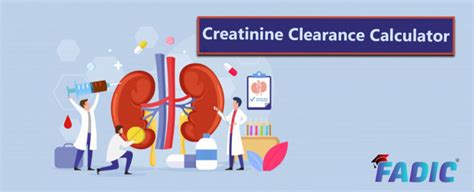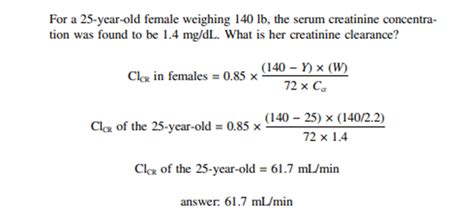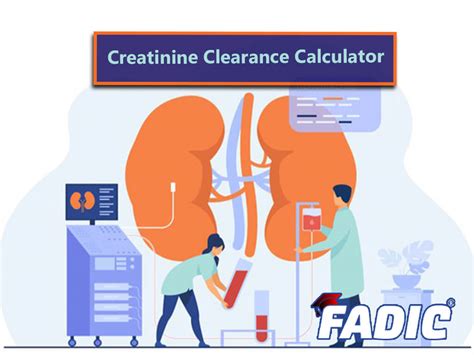Intro
Determine creatinine clearance easily with our guide, covering calculation methods, kidney function tests, and glomerular filtration rate (GFR) analysis for accurate renal assessment and diagnosis.
The kidneys play a vital role in filtering waste and excess fluids from the blood, and creatinine clearance is a crucial measure of kidney function. Creatinine is a waste product that comes from the normal wear and tear on muscles of the body, and the kidneys are responsible for filtering it out of the blood. When kidney function is impaired, creatinine can build up in the blood, leading to serious health complications. Understanding creatinine clearance is essential for healthcare professionals and individuals alike, as it helps to diagnose and monitor kidney disease, as well as adjust medication dosages to prevent toxicity.
Measuring creatinine clearance is a complex process that involves calculating the volume of blood plasma that is cleared of creatinine per unit time. This calculation is typically expressed in milliliters per minute (mL/min) and is used to assess the glomerular filtration rate (GFR), which is a key indicator of kidney function. The GFR is the rate at which the kidneys filter the blood to remove waste and excess fluids, and it is a critical component of creatinine clearance. By understanding how to calculate creatinine clearance, healthcare professionals can gain valuable insights into kidney function and make informed decisions about patient care.
The importance of creatinine clearance cannot be overstated, as it has significant implications for patient health and treatment outcomes. For example, individuals with impaired kidney function may require adjustments to their medication regimens to prevent toxicity, while those with severe kidney disease may require dialysis or kidney transplantation. By accurately measuring creatinine clearance, healthcare professionals can identify individuals at risk of kidney disease and take proactive steps to prevent or slow disease progression. In this article, we will delve into the world of creatinine clearance, exploring the benefits, working mechanisms, and steps involved in measuring this critical indicator of kidney function.
Understanding Creatinine Clearance

Benefits of Measuring Creatinine Clearance
Measuring creatinine clearance has numerous benefits, including: * Diagnosing kidney disease: Creatinine clearance is a critical component of kidney function testing, and it helps healthcare professionals diagnose kidney disease in its early stages. * Monitoring kidney function: Regular measurements of creatinine clearance enable healthcare professionals to monitor kidney function over time, allowing for early detection of any changes or declines in kidney function. * Adjusting medication dosages: Creatinine clearance is essential for adjusting medication dosages in individuals with impaired kidney function, as it helps prevent toxicity and ensures that medications are effective. * Identifying individuals at risk: By measuring creatinine clearance, healthcare professionals can identify individuals at risk of kidney disease and take proactive steps to prevent or slow disease progression.Calculating Creatinine Clearance

Factors Affecting Creatinine Clearance
Several factors can affect creatinine clearance, including: * Age: Kidney function declines with age, and creatinine clearance may be lower in older adults. * Sex: Females tend to have lower creatinine clearance than males due to differences in muscle mass. * Body size: Creatinine clearance is influenced by body size, with larger individuals tend to have higher creatinine clearance. * Diet: A high-protein diet can increase creatinine production, while a low-protein diet can decrease it.Applications of Creatinine Clearance

Limitations of Creatinine Clearance
While creatinine clearance is a valuable tool for assessing kidney function, it has several limitations, including: * Variability: Creatinine clearance can vary from day to day, making it essential to perform multiple measurements to obtain an accurate estimate of kidney function. * Inaccuracy: The 24-hour urine collection method can be prone to errors, such as incomplete collections or contamination. * Limited sensitivity: Creatinine clearance may not detect early changes in kidney function, and it may not be sensitive enough to detect mild kidney disease.Alternatives to Creatinine Clearance

Future Directions
Research is ongoing to develop new methods for assessing kidney function, including: * Biomarkers: Several biomarkers, such as NGAL and KIM-1, have been identified as potential indicators of kidney injury or disease. * Imaging techniques: Advances in imaging techniques, such as MRI and CT scans, may enable healthcare professionals to non-invasively assess kidney function. * Point-of-care testing: The development of point-of-care tests for kidney function could enable healthcare professionals to quickly and easily assess kidney function in a variety of settings.Conclusion and Final Thoughts

Final Reflections

Call to Action

What is creatinine clearance, and why is it important?
+Creatinine clearance is a measure of the kidneys' ability to filter creatinine from the blood, and it is an essential indicator of kidney function. It is crucial for diagnosing and monitoring kidney disease, as well as adjusting medication dosages to prevent toxicity.
How is creatinine clearance calculated?
+Creatinine clearance is calculated using a 24-hour urine collection, serum creatinine measurement, and the formula: GFR = (Urine creatinine x Urine volume) / (Serum creatinine x Time).
What are the limitations of creatinine clearance?
+Creatinine clearance has several limitations, including variability, inaccuracy, and limited sensitivity. It may not detect early changes in kidney function, and it may not be sensitive enough to detect mild kidney disease.
